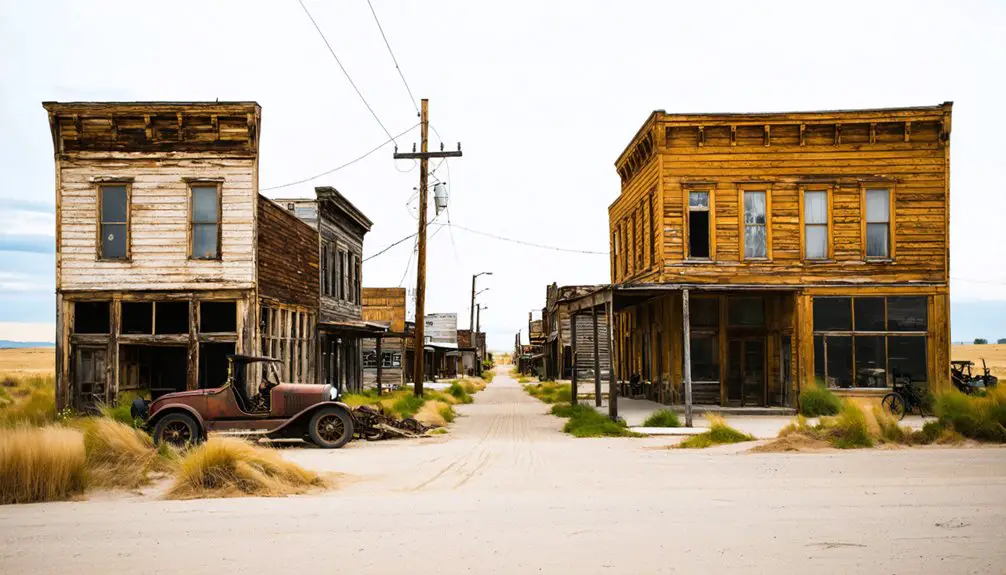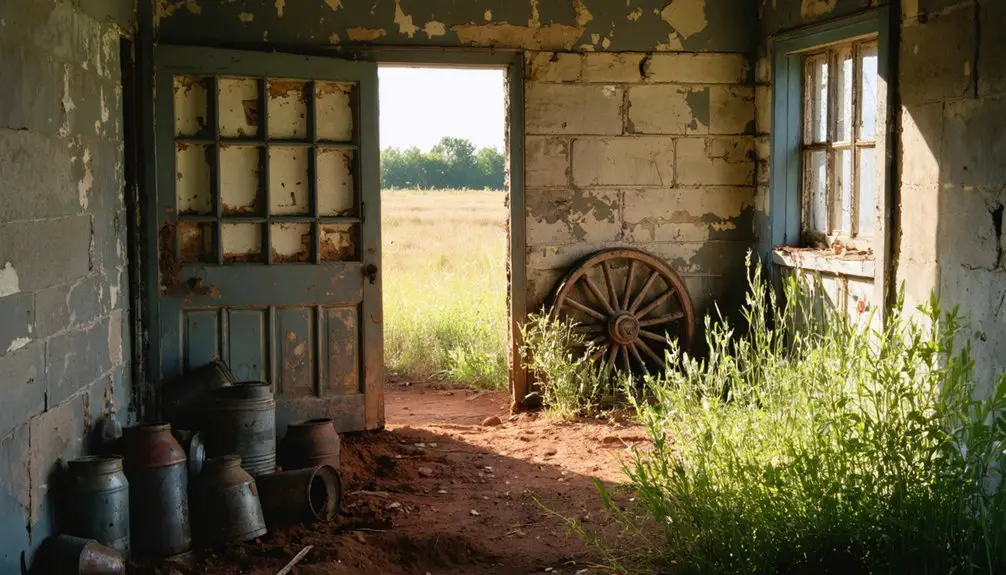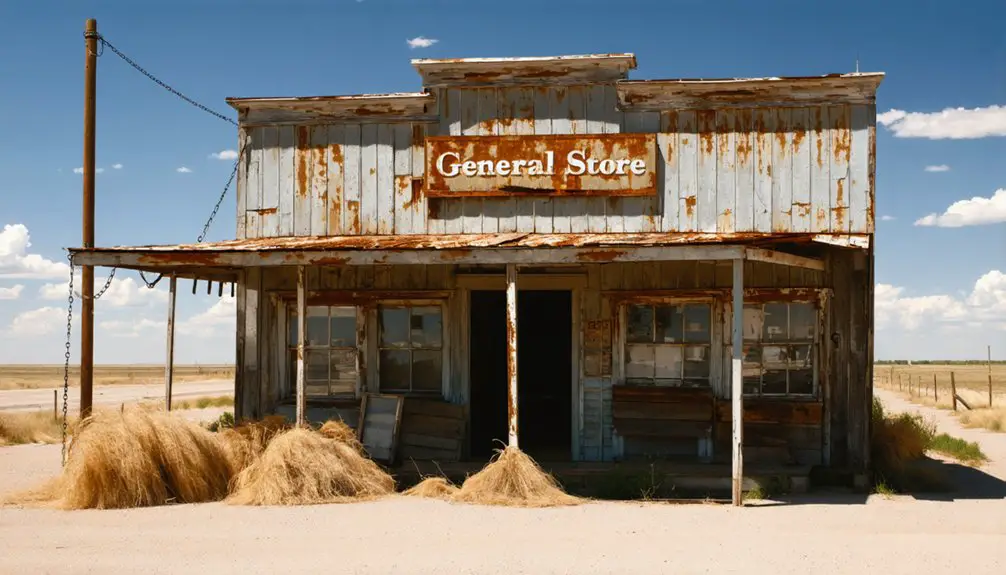You’ll find Quinlan’s ghost town remains in northwestern Oklahoma, where it once flourished as a bustling agricultural hub during the railroad’s golden age (1901-1930). The town featured two churches, multiple saloons, and a vibrant business district serving local farmers and ranchers. After the Dust Bowl and Great Depression struck, Quinlan’s population steadily declined. Today, scattered structural remnants and archaeological discoveries tell a fascinating story of human settlement spanning thousands of years.
Key Takeaways
- Quinlan transformed from a bustling agricultural hub during the railroad’s golden age (1901-1930) to a ghost town by century’s end.
- The Dust Bowl and Great Depression of the 1930s triggered significant population decline and community exodus.
- Economic factors, including agricultural mechanization and highway bypasses, accelerated the town’s abandonment in the mid-1900s.
- Only scattered remnants of frontier-era structures remain, including deteriorating residential buildings and a stone-foundation church.
- Archaeological discoveries in 1963 revealed the area’s rich history, with evidence of human habitation spanning thousands of years.
Early Days and Settlement
While the Cherokee Outlet opened to non-Indian settlement in 1893, the land around Quinlan had already witnessed thousands of years of human activity.
Plains Apache, Comanche, Kiowa, Cheyenne, and Arapaho tribes called this region home, with archaeological evidence revealing Late Prehistoric Plains Village farmers dating back to AD 800. A significant battle near Wolf Creek in 1838 further demonstrates the area’s rich indigenous history. Like many ghost towns in Oklahoma, Quinlan’s story represents one of thousands of communities that rose and fell during the state’s development. The local economy initially thrived on cattle ranching, as the land was leased to the Cherokee Strip Live Stock Association after the Civil War.
Archaeological discoveries show this land nurtured diverse Native American cultures, from ancient Plains Village farmers to multiple tribal nations.
Settlement patterns shifted dramatically when Quinlan was established in 1893.
You’ll find the town’s early community dynamics centered around essential structures – a church, residential buildings, and a post office. These foundations supported the emerging agricultural community, marking a significant change in the region’s history.
Early settlers crafted a close-knit community, building their lives around local commerce and religious gatherings.
From Boomtown to Ghost Town
If you’d visited Quinlan during the railroad’s golden age of 1901-1930, you’d have found a bustling agricultural hub where cattle cars regularly lined the Atchison, Topeka and Santa Fe Railway tracks.
The town’s energy peaked when the railway facilitated robust cattle shipping and agricultural trade, drawing farmers and ranchers from miles around to conduct business. Similar to how Irish businessman Derek Quinlan built successful ventures, early Quinlan residents established thriving commercial enterprises along the railway line.
The population’s steady exodus began in the 1930s as the combined effects of the Dust Bowl and Great Depression drove residents to seek opportunities elsewhere, leaving Quinlan to drift toward its current ghost town status. Like other abandoned towns such as Whizbang, Oklahoma, which was devastated by a powerful tornado in the 1930s, natural disasters often hastened the decline of once-thriving communities.
Railroad’s Golden Age
As railroads rapidly expanded across Indian Territory between 1897 and 1907, Quinlan’s story became intertwined with Oklahoma’s golden age of rail development.
You’ll find the town’s rise mirrored the territory’s broader transformation, as foreign capital from Britain, Germany, and the Netherlands poured into rail construction, creating crucial transportation arteries across the land.
Following ancient trade routes and cattle trails, these new rail lines didn’t just connect Quinlan to larger markets – they brought the promise of prosperity. When the first railroad in 1871 reached Indian Territory through the Missouri-Kansas-Texas line, it set the stage for towns like Quinlan to emerge. The network grew dramatically as Oklahoma expanded from 289 miles of track in 1880 to over 6,500 miles by 1920.
The Missouri, Kansas & Texas (Katy) and other railroads opened doors for local farmers and merchants, while European investment fueled growth in related industries.
It’s a reflection of the economic impact railroads had on small towns like Quinlan, transforming them from isolated outposts into bustling centers of commerce.
Population Exodus Timeline
Although Quinlan’s early 1900s growth painted a promising picture of rural prosperity, the town’s population would steadily erode throughout the twentieth century.
Like many of Oklahoma’s two thousand ghost towns, Quinlan followed a familiar pattern of decline that would ultimately lead to its abandonment.
You can trace the population trends through distinct phases of decline: first, as agricultural mechanization reduced local labor needs in the mid-1900s, then accelerating when highways bypassed the town.
The migration patterns show how younger residents left for urban opportunities while aging locals passed away.
By the late twentieth century, you’d have found only a handful of determined residents remaining, mostly elderly folks or those managing surrounding farmland.
Similar to how Route 66 bypasses devastated towns like Texola, the final wave of exodus came as essential services disappeared – the post office closed, the school shut down, and businesses folded, leaving Quinlan’s structures to slowly decay into the ghost town you’ll find today.
Historical Transportation Hub
Once a bustling transportation nexus, Quinlan thrived as a critical junction where the Atchison, Topeka and Santa Fe Railway converged with regional roadways.
You’d have seen impressive Santa Fe steam locomotives, including 2-8-2 and 2-10-4 configurations, hauling heavy freight through town. A notable example was captured on November 18, 1945 when photographer Preston George documented two massive locomotives double-heading a mixed freight train. The transportation evolution transformed Quinlan into an essential agricultural shipping point, with double-headed engines testifying to the freight significance of this strategic location. The town’s early growth led to a population of 310 by 1910.
Situated about twenty miles east of Woodward and 1.5 miles north of today’s U.S. Highway 412, Quinlan’s infrastructure supported both rail and road transport.
The town’s position near the Cherokee Strip made it an ideal transfer point, where local farmers could connect their products to national markets through an efficient network of rails and highways.
Local Commerce and Trade
While Quinlan’s economy centered on agriculture, the town’s commercial footprint extended beyond just farming to include a modest but significant business district.
You’d find the usual merchant establishments serving local farmers and travelers – general stores stocking necessities, feed stores supporting livestock operations, and basic services important to rural life.
The town’s connection to regional trade networks, particularly through railroad links, proved critical for its commerce until their eventual abandonment.
You’ll appreciate knowing these key elements that shaped local trade:
- Agricultural goods formed the backbone of commerce, with wheat and cattle leading exports
- Local merchants supplied important farm implements and daily necessities
- Railroad access enabled broader market reach, though its loss accelerated the town’s decline
Social Life and Entertainment

Despite its modest size, Quinlan fostered a vibrant social scene centered around its saloons, churches, and community gathering spots. You’d find two to three bustling saloons where cattle buyers and locals exchanged news and enjoyed frontier entertainment.
The town’s two churches weren’t just places of worship – they formed essential social networks through holiday celebrations and community gatherings.
The local school brought families together through plays and sporting events, while the Quinlan Mirror kept everyone connected with weekly updates on social happenings.
If you were a visitor, you’d have your pick of two hotels, where parlors buzzed with conversation and casual entertainment.
Between the newspaper’s cultural commentary and the various venues for socializing, Quinlan’s residents enjoyed a surprisingly rich social life for a frontier town.
Architectural Heritage
As time and weather have taken their toll on Quinlan’s architectural legacy, you’ll find only scattered remnants of its frontier-era structures today.
The town’s architectural styles reflect the practical needs of late 19th and early 20th century settlers, with wooden frame construction dominating the landscape.
While preservation challenges have led to significant deterioration, you can still explore:
- The church building, which stands as the most prominent survivor, likely incorporating local stone foundations beneath its weathered frame
- A handful of deteriorating residential and commercial structures that showcase the simple, functional design of Oklahoma’s frontier architecture
- Evidence of traditional building methods, including wooden frame construction and period-appropriate roofing materials
These remaining structures face ongoing threats from natural erosion and vandalism, making each visit a precious glimpse into Oklahoma’s pioneering past.
Demographics Through Time

The story of Quinlan’s population mirrors the rise and fall of many frontier settlements in Oklahoma. From its peak of 695 residents in 1930, you’ll find the town has dwindled to just 28 people by 2020, spread across less than a third of a square mile.
These dramatic demographic shifts tell a tale of changing times in rural America.
Today’s Quinlan shows you a mostly white community with a median age of 50, reflecting an aging population that’s struggled to retain younger generations.
While Woodward County maintains a more diverse mix of residents, Quinlan’s composition has remained relatively homogeneous.
The town’s transformation from a bustling community to near ghost town status reflects broader patterns of rural exodus, as agricultural decline and economic changes have reshaped Oklahoma’s countryside.
Agricultural Legacy
Behind Quinlan’s steady population decline lies a rich agricultural heritage stretching back to the early 1900s.
You’ll find that this once-thriving farming community showcased remarkable crop diversity, with wheat dominating the landscape alongside other essential grains. The town’s strategic location near U.S. Highway 412 and historical cattle trails supported both crop production and ranching operations.
- Early settlers mastered traditional farming techniques that maximized the fertile prairie soil.
- Local farmers adapted their methods through challenging periods, especially during the 1930s Dust Bowl.
- The community’s agricultural infrastructure included crucial transport routes for getting products to market.
The harsh reality of drought and environmental challenges eventually forced many farmers to abandon their land, but Quinlan’s agricultural legacy lives on through the preserved remnants of homesteads and the enduring cemetery that marks this once-prosperous farming settlement.
Archaeological Significance

Since its unexpected discovery in 1963, Quinlan’s archaeological treasures have revealed a rich tapestry of human habitation spanning thousands of years.
You’ll find evidence of ancient big game hunters, Plains Village farmers, and various tribal groups who’ve called this land home through the ages.
Archaeological methods have uncovered remarkable artifacts in the cave’s 22-inch soil layers, from Archaic-period projectile points to Mississippian pottery sherds, demonstrating impressive cultural continuity.
While early pothunters unfortunately disturbed human burials before proper preservation laws existed, the Oklahoma Anthropological Society’s volunteer excavations helped save vital historical data.
Today, the site’s discoveries continue teaching us about sophisticated hunting strategies, farming practices, and the complex relationships indigenous peoples maintained with this landscape from 14,000 years ago through the 19th century.
Frequently Asked Questions
Are There Any Remaining Original Buildings Still Standing in Quinlan Today?
Like fading footprints in shifting sands, you won’t find any original buildings standing today. Despite the area’s historic architecture legacy, no preservation efforts saved structures from time’s relentless march forward.
What Natural Disasters or Events Contributed to Quinlan’s Population Decline?
You’ll find flood impacts and drought effects likely played a role, though there’s no single documented disaster. The town faced typical Oklahoma weather challenges that wore down local farming and commerce.
Did Any Famous People or Historical Figures Ever Visit Quinlan?
You won’t find any famous visitors in the historical records. While the town served ranchers and farmers through its railroad stop, no historically significant figures are documented as having visited.
What Happened to the Railroad Tracks That Once Served Quinlan?
You won’t find those tracks anymore – they’ve been completely removed. The Santa Fe Railroad lines that once defined Quinlan’s legacy were dismantled during the widespread railroad abandonments of the mid-20th century.
Are There Any Annual Events or Reunions Held by Former Residents?
Despite 100% of ghost towns facing challenges with reunion planning, you won’t find any annual events here. There’s no documented community involvement in organizing formal gatherings for former residents or their descendants.
References
- https://sites.rootsweb.com/~okghstwn/woodward/woodward.htm
- https://en.wikipedia.org/wiki/List_of_ghost_towns_in_Oklahoma
- https://www.okhistory.org/publications/enc/entry?entry=WO017
- https://okielegacy.net/journal/tabloid/?ID=4364&vol=11&iss=21
- https://en.wikipedia.org/wiki/Quinlan
- https://www.kosu.org/local-news/2014-05-23/ghost-towns-all-black-oklahoma-towns
- https://kids.kiddle.co/List_of_ghost_towns_in_Oklahoma
- http://www.ou.edu/news/articles/2024/may/ou-researcher-unveils-book-of-oklahomas-ghost-towns.html
- https://nondoc.com/2022/01/04/whizbang-oklahoma-ghost-town/
- https://www.publicradiotulsa.org/studiotulsa/2015-07-27/boomtown-an-american-journey-a-new-documentary-film-about-tulsa



